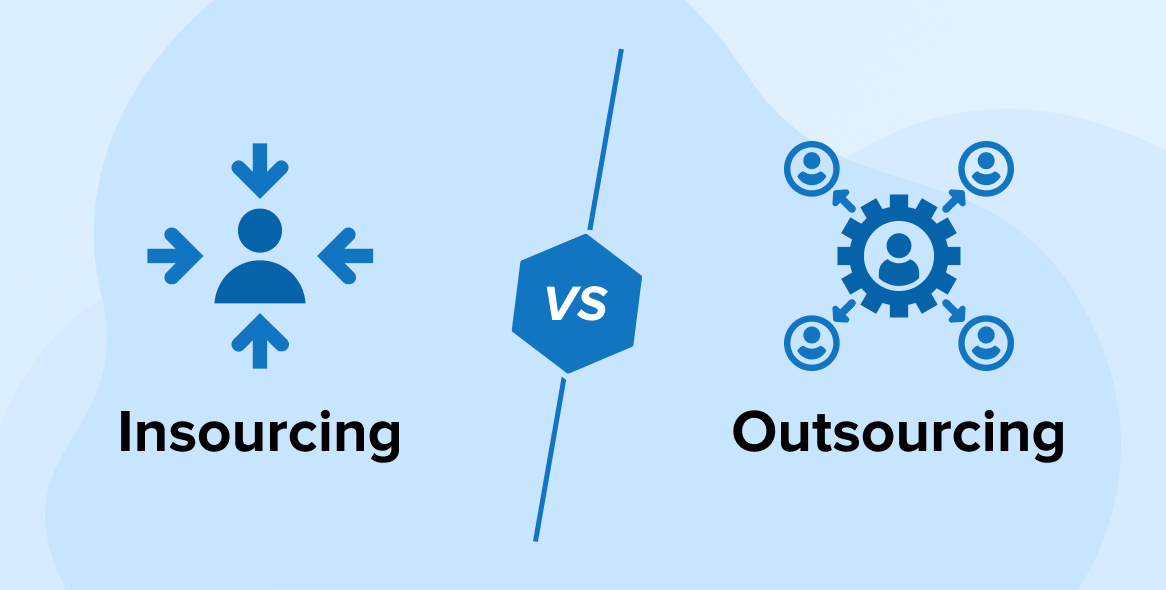
Gone are the days when organizations would refuse to seek external help. Today, the concept of outsourcing seems to be evolving at a breakneck pace and so do we. To keep up with the current pace of innovation, ever-changing customer expectations, and a complex security landscape, we do need a helping hand. With increasing cut-throat competition around, the market seems to have become quite a roller-coaster ride where one tiny vulnerability can take down a company. The following post emphasizes on what is the current state of the Software development Outsourcing Market, several IT outsourcing models, IT outsourcing services, and their types to take into account.
1. The Rise of Outsourcing in Software Development
According to Statista, global IT contracts are currently worth an estimated $66.5B, with that number expected to rise in the coming months and years. So it’s just the COVID factor driving demand for software outsourcing here? Nope, not really!
Outsourcing is doing what you do the best in-house and delegating the other tasks that are not your core competency to qualified onshore, nearshore, or offshore third-party vendors. The outside development company or service provider or a third-party provider arranges for its own workers or computer systems to perform the tasks or services either on-site at the hiring company’s own facilities or at external locations.
You know for any company to effectively outsource responsibilities, it is important to focus on the business partnership as much as the logistics. Here outsourcing software development is all about managing relationships more than service-level agreements and is a partnership, not a purchasing project.
Maintaining and securing a trusted relationship is essential in outsourcing efforts and is more complex than establishing service levels and relationships.
1.1 Why Outsource a Dedicated Development Team?
These days companies often outsource software development services as a sure-shot way to lower costs, improve efficiencies and gain speed. Companies sometimes opt to outsource as a way to shift meeting regulatory requirements or obligations to the third-party provider.
Some of the core advantages of outsourcing include:
- Overall cost advantage – It eludes the need to hire individuals in‐house; hence recruitment and operational costs can be minimized to a great extent. It reduces the cost and also saves time and effort on training costs.
- Stimulates Entrepreneurship – Outsourcing software development stimulates Entrepreneurship, Employment, and Exports in the country from where outsourcing is done. Say, for example, countries like Vietnam, the Philippines, India, etc.
- Low manpower costs – And since outsourcing a development team is much lower than that of the host country. This is exactly the case with India. We have a very large educated workforce. And this causes the software development labor cost in our country to be much lower.
- Access to high-end professionals – Mostly, the tasks are given to people who are skilled in that particular field. This provides us with a better level of service and fewer chances of errors or misjudgment.
- Enhanced efficiency and productivity – An outsourcing development team brings in specialized knowledge and experience, leading to an increase in the productivity and efficiency of your business.
Other crucial benefits of choosing IT outsourcing models include focusing on core functions, solving capability issues, great global scalability, improved service quality, managing business environments, and a lot more.
2. Know Your Right Outsourcing Model
Staying competitive in the business landscape requires being unquestionably decisive and strategic. In one and many ways, outsourcing equips your firm better for getting on a higher gear. But how do you know which outsourcing model best fits your needs? Time to overview 3 outsourcing models: full process outsourcing, dedicated teams, and staff augmentation.
2.1 Full Process Outsourcing
This is one of the most popular outsourcing models found in the software development industry. Here a vendor takes over the whole development process, with full responsibility for team organization and management, quality of the results, and accompanying risks. Now when you must think of full process outsourcing?
If you don’t possess development expertise at all or for particular software to be developed, or if you’re overloaded with other projects in the pipeline.
Its pros include:
- Minimum management efforts on your side and freed time to focus on core business activities.
- High quality of deliverables and timeline alignment guaranteed by SLA (with penalties for breaching it).
- Access to a vendor’s development process expertise and best practices.
- Tackling project-related risks is on a vendor’s side.
All you require to do is ask for transparent reporting and dedicate a representative who will keep active communication with a vendor.
2.2 Dedicated Team Outsourcing Model
Another interesting outsourcing model is a dedicated team model. Here software development vendor integrates with your in-house development team and/or your other vendor and works on an outsourced part of the project, sharing risks and responsibility for the quality. Dedicated teams are the perfect choice when the scope of work is hard to estimate. Your vendor provides you with a dedicated team of developers that are only dedicated to your project. Team management stays on a vendor’s side, and their project manager reports regularly to your PM (or product owner) on the progress.
Benefits of such types of outsourcing models include:
- The fastest ramp-up: the teams are usually pre-assembled by a vendor and their structure is further adjusted to your project needs (adding or excluding team members).
- Such IT outsourcing models tend to save time and effort on project management with complete control of the results retained.
- Full technical ownership with access to a vendor’s expertise & specific skills at the same time.
Here try looking for a software development vendor who ensures responsibility to seamlessly merge with your development and communication environment and set up all the needed tools for it.
2.3 Staff Augmentation Outsourcing Model
Last but certainly not the least option to choose among IT outsourcing models include staff augmentation. Staff augmentation can be considered a slow development process or a shortage of rare or advanced expertise. Also, with staff augmentation model is said when you need just 1-3 resources, not a complete team.
Now, why is it named among the top 3 IT outsourcing models in the software development world?
- Flexibility – Getting the exact number of experts you need, from 0.5 full-time equivalents (FTE) to 100 FTE and above. Note that the dedicated team option becomes more effective starting from 10 FTE.
- One can observe easy scaling up and down. Due to such an outsourcing model, businesses can adapt to changes very easily.
- Suitability for both long-term and short-term engagement.
3. Types of IT Outsourcing
Following are the types of IT outsourcing:
3.1 Business Process Outsourcing
In the software development realm, the term business process outsourcing means complex secondary technological processes with constantly changing composition. Now, what does this outsourcing model include? It includes finance and accounting, labor, supply, payroll accounting and accounting, internal audit, tax calculation, customer service centers, and a number of industry-specific processes.
3.2 IT Outsourcing
This is one of the most common services available today! Outsourcing IT involves subcontracting an outside organization to take care of all or part of a business’s IT needs, which range from software development to maintenance and support.
Of course, every business is found looking for an IT development team or at least works with technology on some level, making it a commonly outsourced department. For many companies, it ends up being less expensive to contract a third-party IT management team than to build an in-house one. Enterprises will often use IT outsourcing to store and manage data, but most large businesses only outsource a portion of IT functions.
3.3 Production and Housekeeping Outsourcing
Another interesting type of outsourcing model is production and housekeeping. This dedicated team model must be taken into account only when your all concerns are related to administrative and lumper jobs like real estate operations, cleaning, cooking, the company’s transport fleet management, goods inventory, and other service work fall on the outsourcing company’s shoulders.
3.4 Project Outsourcing
It may quite interest you to know that there are times when companies find trouble while managing different projects or even if it’s about accomplishing a small portion of a specific project. This is why many will outsource the project to a reputable project management company. Chances are pretty high that the opposite company may not have enough in-house people with the necessary skills to work on the project. It may also cost more to complete the project in-house than to outsource to another, more qualified company.
3.5 Healthcare Outsourcing
Now you must be wondering what technologies can a healthcare provider outsource or why even there is a need for a development team? Well, healthcare IT outsourcing might be a new term but that doesn’t make it less important.
Some of the most famous medical solutions offered by a dedicated team include:
- Electronic Health Records
- Hospital Information System
- Revenue Cycle Management
- Pharmacy Information
- Laboratory Information Systems
- Clinical Decision Support
- Hospital Management Systems
- E-Prescriptions
- Hospital Inventory Management
- Other important applications like PACS – Picture Archiving and Communication Systems
And you know what healthcare industries are using IT outsourcing for several years now irrespective of the reason, clinical to administrative needs, there is more and more push to incorporate sophisticated systems for electronic health records, population health management, and analytics. On and all, outsourcing a development team boils down to reducing costs.
4. Conclusion
So do you think, the outsourcing dedicated development team is right for your business? Well, it’s high time when you start considering a reliable dedicated team or an outsourcing partner.






It is very essential for businesses to understand major outsourcing models adopted by various IT companies all around the world. This will help businesses to strategize the process accordingly and avoid any conflict or roadblock. Information shared in this article is very beneficial while selecting the right IT outsourcing Model.
If you think outsourcing is just hiring a third party service provider which is located outside your country then you must read this article. It discusses various type of outsourcing and models, which you will require when you really outsource your project.